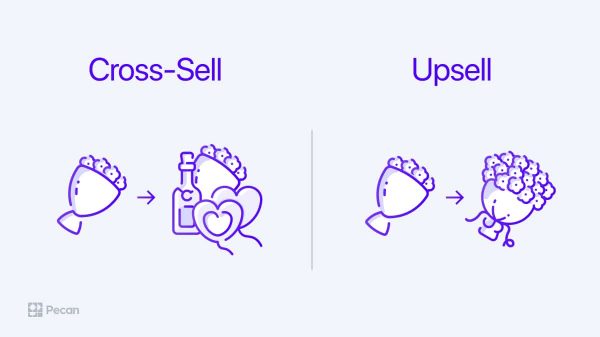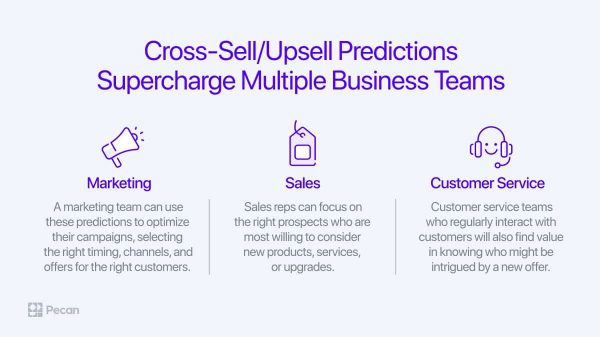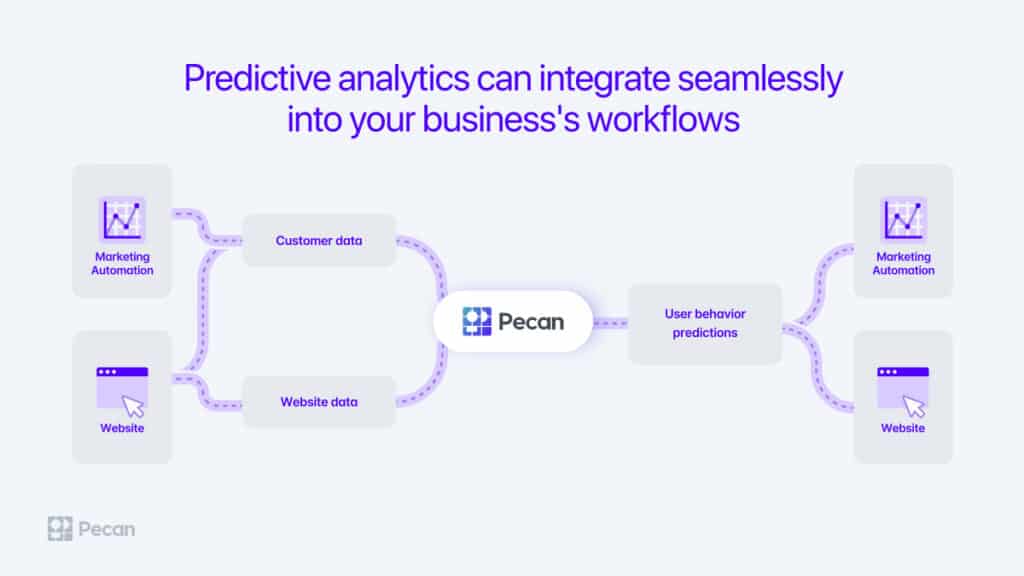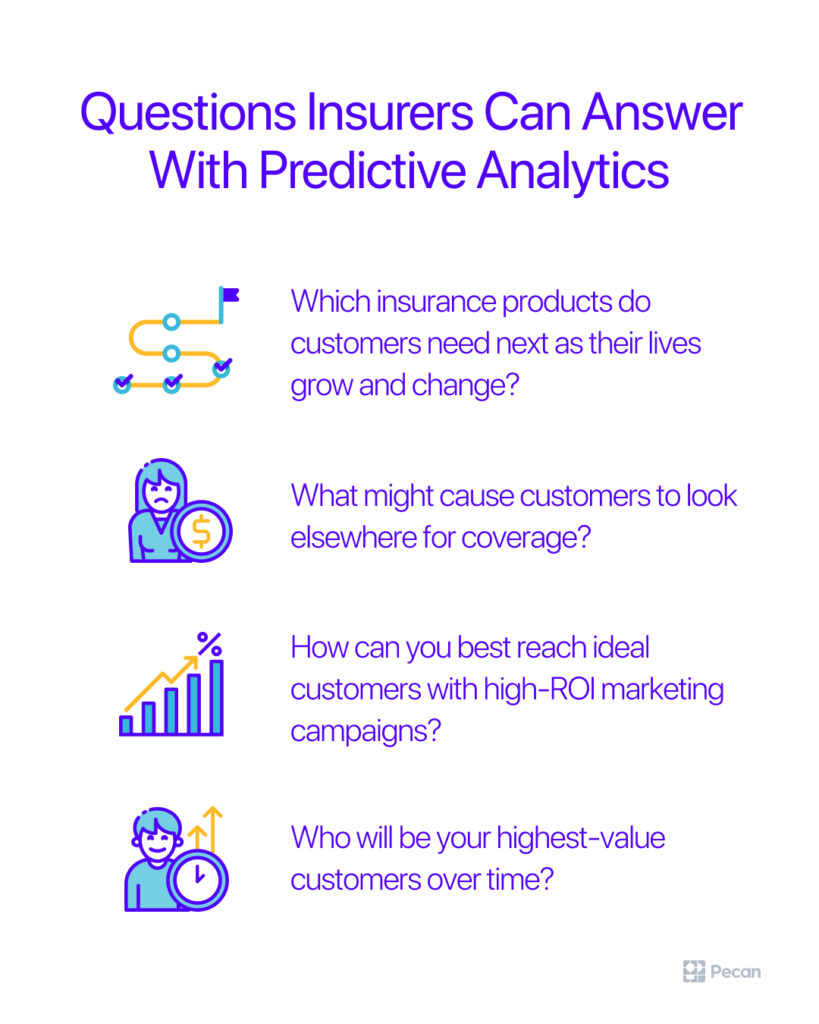In a nutshell:
- Predictive analytics can help businesses optimize cross-sell and upsell programs for more conversions and revenue.
- Predictive modeling identifies patterns in customer data to enhance cross-sell and upsell strategies.
- Investing in predictive modeling can generate significant ROI for businesses with expensive outbound sales methods or limited sales resources.
- Use existing CRM data to predict cross-sell and upsell success, integrating supplemental data for better performance.
- Combine upsell and cross-sell models to recommend the best offers for customers and predict effective outreach channels.
Have limitless funds for sales and marketing? Nah, us either. That’s why you’re reading a blog post instead of watching our custom-produced feature film, starring famous action heroes using predictive analytics to save the world — with a dash of romance, of course.
We all want to use sales and marketing resources efficiently. Once you’ve acquired a customer, building on their existing business is easier and cheaper than acquiring new customers. Optimized cross-sell and upsell programs bring immediate bang for your buck. You’ll focus time and money where they pay off.
Fortunately, today’s predictive analytics methods mathematically analyze your existing customers’ data, including transactions, demographics, and user behavior. Then, they identify who will most likely take you up on a cross-sell or upsell offer.
Predicting success: more conversions, more revenue, and better processes
Predictive analytics finds patterns in massive amounts of customer data that are too complex for humans to recognize. It’s a more dynamic approach than BI-based methods, like static business rules or manual segmentation. Those methods can’t adapt on the fly to rapidly evolving conditions.
As the Harvard Business Review recently explored, using integrated customer data with advanced analytics and automation is key to successfully personalizing and streamlining omnichannel sales and marketing at scale. Moreover, companies that implemented personalization efforts, like customized cross-sell offers, have seen revenue growth of 6 to 10%. Additionally, they’ve benefited from increased net incremental revenue due to those personalization initiatives from 40 to 100%.
You’ll achieve more conversions, generate more revenue in the same amount of time, and enhance your selling or marketing processes. And with Pecan, you won’t even need data scientists to achieve these goals.
Predictive modeling boosts the breadth and depth of customers’ purchases
First, let’s quickly review what cross-sell and upsell strategies are. Then, we’ll dive into how predictive analytics for cross-sell and upsell enhances these strategies.
Cross-sell strategies try to identify which complementary products or services existing customers might like to add to their current purchases. For example, an insurance company might want to find auto policyholders who could be interested in homeowner’s insurance.
In contrast, upsell strategies encourage customers to elevate their existing purchases to the next level. For example, they might opt for a higher service level or an upgraded product version. For instance, a pet supplies subscription service could identify customers most likely to upgrade from a basic subscription to one with more toys and treats.
Predictive cross-sell/upsell modeling benefits all businesses, with an extra payoff for some
In general, there are a variety of ways business teams might use cross-sell and upsell predictions. But regardless of who ultimately acts on the information, you’ll achieve more with available resources.
There are a few situations where investing in this kind of predictive modeling can generate really significant ROI:
- If your outbound sales method is relatively expensive. If you invest substantially in each outreach to customers, you want to allocate resources to the most likely prospects. For example, outbound call centers need to assign staff time to the most promising customers. (Here’s an example of how this worked for one Pecan customer.)
- If your customers are easily put off by unwanted outreach. Indeed, reaching out to customers who don’t want to be targeted could damage your relationship with them. Instead, focus on customers interested in buying who welcome your attention.
- If you have many customers and not enough sales resources. Using predictive modeling to prioritize customers can direct limited sales attention fruitfully.
- If every deal means a lot. The ROI from predictive analytics is fast and rewarding when your product is relatively expensive. Gaining a fairly small number of new purchases can be meaningful. Customer lifetime value may see a substantial boost.
Sound appealing? Let’s look at what you’d need to try this out.
Put your data to work today to predict cross-sell/upsell success
In truth, your existing CRM data is a fantastic starting point for cross-sell/upsell prediction models. Transaction data showing past sales is key to building these machine learning models, plus customer demographic data. Additionally, product master data that includes pricing and promotional information is important.
You can also integrate supplemental internal and external data to make these predictive models perform even better. For example, information on special dates, important locations, holidays, weather, events, and more can enrich your marketing team’s existing data. (And even if you don’t think your data is ready … it probably is.) The beauty of predictive modeling is that it can ingest, combine, and find relationships within more data than traditional analytics approaches.
Using your data, cross-sell/upsell predictive models score each customer’s likelihood of responding positively to your offer. Typically, those scores are fed into your CRM, marketing automation software, or call center software. You can then prioritize your outreach through whichever channels matter most for your business.
An example of integrating your data and Pecan’s predictions into your business workflows; many other combinations of platforms and tools are possible
How to act on upsell and cross-sell predictions
You might be wondering, though, what exactly you should offer these prioritized customers. It’s possible to combine upsell and cross-sell models with a model that recommends the “next best offer” for each customer. That kind of modeling not only suggests who is more likely to buy additional products and services, but also what might excite them the most.
And finally, it’s often even possible to predict when and through which channel you might most effectively reach a customer.
These predictions can transform your entire approach to sales and marketing. Instead of making informed guesses based on overly broad customer segments and historical data, you can anticipate future customer behavior. You’ll be perfectly positioned to fulfill customers’ desires.
Up next: success stories and a glimpse behind the scenes
Now you’ve seen how predictive modeling refines cross-sell/upsell strategies, take a look at the sequel to this post. In it, we share some success stories and great ways these strategies are used in various industries. In addition, we peek inside how these data science models work. (Don’t worry – we’ll skip the equations and Greek symbols.)
Who needs celebrities? With cross-sell and upsell modeling playing a key role in your business, you’ll be well on your way to becoming a predictive-analytics action hero yourself.
If you’re looking for the right predictive analytics solution for your team, maybe you’ve found it! Pecan automates the predictive analytics process, without needing data scientists.
If you’d like to assess your predictive readiness, request a use-case consultation. We’ll help you find the best way to handle cross-sell and upsell prediction.






